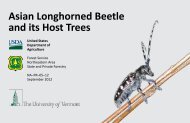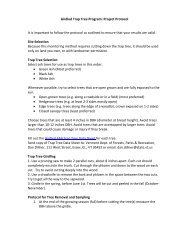BUCKTHORN - Vermont Invasives
BUCKTHORN - Vermont Invasives
BUCKTHORN - Vermont Invasives
You also want an ePaper? Increase the reach of your titles
YUMPU automatically turns print PDFs into web optimized ePapers that Google loves.
<strong>BUCKTHORN</strong><br />
invasive<br />
fact sheet<br />
© Leslie Mehrhoff/IPANE<br />
Buckthorn replaces<br />
native trees and shrubs in<br />
<strong>Vermont</strong>’s forests and<br />
fields. It is easy to see in<br />
the fall when its dark<br />
blue berries cover the<br />
tree’s branches.<br />
common buckthorn<br />
glossy buckthorn<br />
common buckthorn (Rhamnus cathartica )<br />
opposite, toothed leaves with “u” vein<br />
alternate<br />
glossy<br />
leaves<br />
orange<br />
tissue<br />
glossy buckthorn (Rhamnus frangula )<br />
Photos © John Randall/The Nature Conservancy<br />
unripe<br />
red<br />
berries<br />
♦<br />
♦<br />
♦<br />
The Problem<br />
© 2006 Jenn Forman Orth<br />
Birds and mammals feed on buckthorn berries<br />
during the winter, aiding in the dispersal of seeds.<br />
While buckthorn may benefit from this behavior,<br />
the feeding animals do not. Buckthorn berries<br />
contain emodin, a natural laxative, that prevents<br />
mammals from digesting sugars found in the berries,<br />
like this Eastern chipmunk shown above.<br />
Like many other invasive trees and shrubs, buckthorn<br />
leafs out early and retains its leaves into late<br />
fall, giving it a much longer advantageous growing<br />
season than native plants.<br />
Buckthorn can increase the amount of nitrogen in<br />
the soil, impacting the composition of native species<br />
that can grow in the area.<br />
The Nature Conservancy, Montpelier, <strong>Vermont</strong><br />
802-229-4425 x120<br />
www.vtinvasives.org
<strong>BUCKTHORN</strong><br />
Integrated Invasive Plant Management<br />
Most landowners have more than one invasive plant species on their property. Before you head for the clippers, develop a management plan. A well-developed plan that is<br />
specific to your property will help you save time and money, increase long-term effectiveness, and reduce the spread of invasives.<br />
√ Create land management goals. Determine what natural features you are most interested in protecting and what wildlife management,<br />
forestry activities or trail building goals you have for the next 5—20 years, and what you want the land to be like in 200 years.<br />
√ Map the invasive species on your property and the surrounding area. Look for invasive plants along logging roads and trails, and other<br />
openings in the forest canopy. Roughly map the species that you find, and convey a sense of the size and density of the populations.<br />
√<br />
Practice Early Detection and Rapid Response (EDRR). Each year, walk your entire property. Look for and remove new occurrences<br />
of invasive species. Stay up to date on what invasive species are coming into your area.<br />
√<br />
Consider available resources and develop a timeline. Be realistic with the time and money you have and set goals accordingly. Based on<br />
what resources you have available, time your work accordingly.<br />
√<br />
Determine a weed- or site-led management approach. Site-led management is designed for the landowner interested in protecting a particular<br />
resource or natural feature from encroachment. Weed-led management approaches the problem from a single-species perspective.<br />
Your approach may change from one part of your property to another, depending upon the species present, natural features, vegetation<br />
types, and land management goals.<br />
√<br />
Integrate invasive species prevention and management into all of your land management activities. Certain land management activities<br />
may spread invasive species. Predict what activities (e.g. logging, construction of trails, roads or buildings) will cause future problems<br />
and take necessary precautions. For example, after spending time in an area that has invasive plants, check clothing for seeds and<br />
remove soil from shoe soles. Require that any logging, mowing or excavation equipment that comes on your property is weed-free.<br />
Monitor new plantings, whether within designed landscapes or natural settings, for invasives that may have been present in imported<br />
soil. Before doing a cut in a timber stand, remove all invasives. Ask your forester to incorporate invasive plant management into your<br />
land management plan.<br />
Mechanical removal:<br />
Hand pull: Any time of year when the ground is soft,<br />
especially after a rain, hand pull small plants by the base<br />
of the stem. Be sure to pull up the entire root system.<br />
Hang from a branch to prevent re-rooting. For larger<br />
plants, use a Weed Wrench. Continue to monitor the<br />
area every year for new seedlings.<br />
Cut stump: Cut plants back any time of year. Wrap a<br />
few layers of burlap or thick plastic over the stump and<br />
tie tightly with twine. You will need to check stumps periodically<br />
and cut back any new growth.<br />
Chemical removal:<br />
Cut stump: Cut the plant 4 inches above the ground. Use a<br />
drip bottle to apply a 18-21% glyphosate solution to the stump<br />
within one hour of cutting. This is best done in late summer<br />
through winter when plants are transporting resources to their<br />
root systems.<br />
Low volume foliar spray: This method is used for dense<br />
populations and best left to a contractor. In the fall, when native<br />
plants are losing their leaves, spray a 2% glyphosate or triclopyr<br />
solution on the entire leaf surface of the plant. In order to avoid<br />
√<br />
√<br />
√<br />
√<br />
√<br />
Safe Chemical Application<br />
The label found on the herbicide container is the law. Read this label in its entirety. It will teach you what concentrations<br />
to use, what protective clothing to wear, how to apply the product, and what environmental and human health hazards<br />
are associated with the chemical. Improperly used herbicides can cause both short- and long-term health and<br />
environmental problems. More is not better! Pesticide labels can be found at http://www.msds.com/.<br />
Use aquatic formulations within 10 feet of water. You need a permit to apply herbicides in wetlands. You cannot apply<br />
herbicides within 100 feet of a wellhead. Contact VT DEC at 802-241-3761 for more information.<br />
You need to be certified to apply herbicides on land that you do not own.<br />
Hire a contractor to manage large infestations. A good contractor will have the knowledge to help create an effective<br />
management plan. For a list of certified contractors, contact the Department of Agriculture at 802-828-3482.<br />
Develop an Integrated Plant Management approach. Use chemical control as only ONE piece of your prevention and<br />
management strategy.<br />
The Nature Conservancy, Montpelier, <strong>Vermont</strong><br />
802-229-4425 x120<br />
www.vtinvasives.ort














